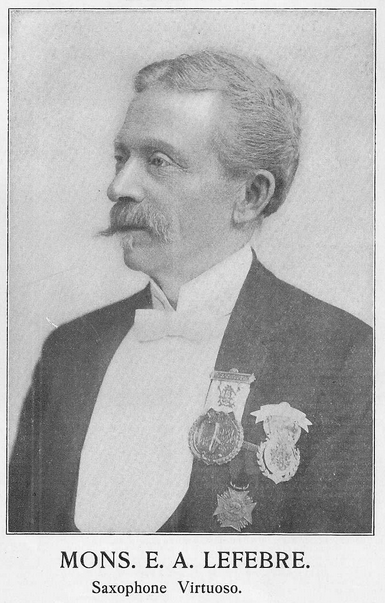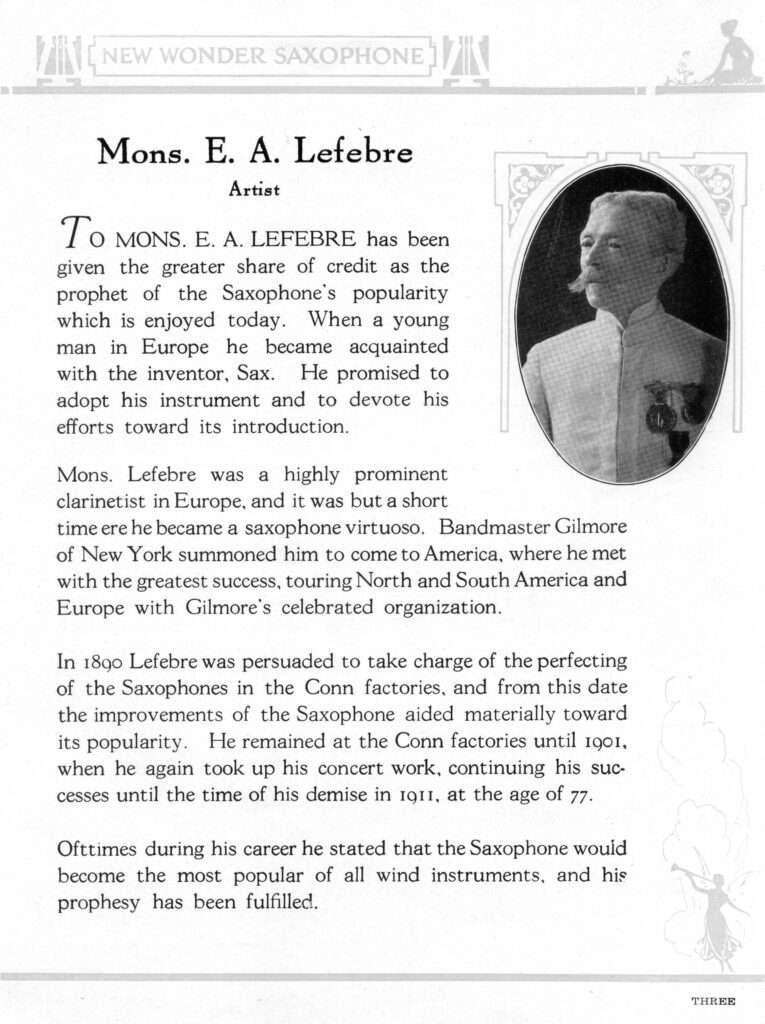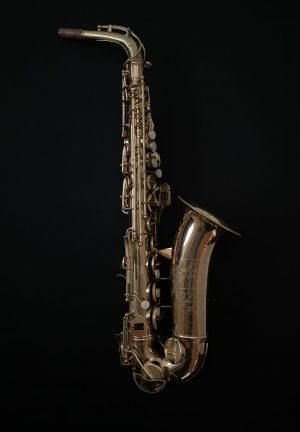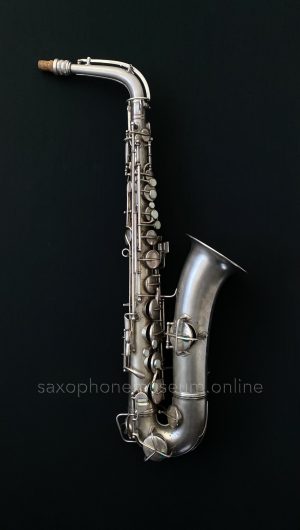Eduard Abraham Lefèbre was an early saxophonist from the Hague, Netherlands. Lefèbre’s activities had a major influence on the global development of the saxophone. ‘The saxophone King’, as he was called, was incredibly popular because of his hitherto unknown instrument and his impressive technique. Who was he?
Table of Contents
Early Life
According to the birth certificate I found, Eduard Abraham Le Fèbre was born on September 16th, 1835. His father was Louis Joseph le Fèbre, himself also a musician (organist) and director of Weijgand & Co.: a music publishing company that amongst others featured music by Dunkler in its catalogue.
Eduard Lefèbre (this is the most common spelling) started playing the saxophone after meeting Adolphe Sax in Paris.
Dagblad van Zuidholland en ‘s Gravenhage of July 14th 1858, reports on a journey of Dunkler’s orchestra of the Grenadiers and Hunters to Antwerp. In that report E.A. Lefèbre is mentioned as a musician. So at least in that year he is a member of this orchestra in The Hague.
In 1859 he travelled to Cape Town, South Africa, where he held a prominent role in a German choral society and managed a music shop, likely supported by his family’s business. Following his return to the Netherlands in 1863 and subsequent marriage, he spent six years working in his father’s company. From that moment on several announcements of concerts in which Eduard Lefèbre participates appear in Dutch daily papers.
A review in Dagblad van Zuidholland and ‘s Gravenhage, 71, provides the following account of a concert:
‘[…] Furthermore, the soiree was graced by the playing of Mr. Lefèbre, who proved, especially in the méditation de Bach, of Gounod, for piano, organ and saxophone, that he has lost nothing of his mastery of the latter instrument during his absence.’
International career
In 1869 he accepted a position as saxophonist in the orchestra of “the Royal Alhambra Palace” in Leicester Square, London. Composer Charles Gounod hears him play in this line-up in 1871, and compliments him on his playing.
Two years later he performed concerts in Hanover, Berlin, Hamburg, Dresden, Wiesbaden, Stockholm and Denmark. He also came to the USA in that year, as accompanist of the famous vocalist Madame Euphrosyne Parepa-Rosa. At that point in time, he met Patrick Gilmore, whose orchestra he then played with from 1873 onwards.
At that time Lefèbre was also the leader of “the New York Saxophone Quartette Club”, one of the first American saxophone quartets (1873-1875).
In 1878 the orchestra of Gilmore toured Europe. During the German part of the tour, Lefèbre received commendation from the German composer Wagner. From the Dutch newspaper Het Nieuws van den Dag, June 28th 1878:
De Amerikaansche musici, die heden in den Haag en morgen te Amsterdam optreden, kunnen al aanstonds op een hartelijk welkom rekenen, dat hen zeker aangenaam zal stemmen. Uit oude betrekking van ons land tot de Vereenigde Staten hebben – naar men ons mededeelt – de gemeente- besturen van den Haag en van Amsterdam gezorgd dat het muziekkorps bij aankomst aan die stations een vriendschappelijke ontvangst bereidt wordt. Trouwens in Engeland gebeurde dat ook in de plaatsen waar zij optraden, en in Brussel heeft men er ook het voornemen toe. In het gezelschap bevindt zich een landgenoot, de heer Lefebre, uit den Haag, solo—saxophonist.
Translation
The American musicians, who will perform in The Hague today and in Amsterdam tomorrow, can immediately count on a warm welcome, which will certainly please them. Honouring our country’s ancient relationship with the United States, the municipal authorities of The Hague and Amsterdam have – as we are informed – ensured that the local bands prepare a friendly welcome upon arrival at these stations. Incidentally, in England, this was also the case in the places where they performed, and in Brussels they also intend to do so. The company includes a fellow countryman, Mr Lefebre, from The Hague, as solo saxophonist.
The repertoire Eduard Lefèbre played on the saxophone consisted of his own written works, but also of original compositions by Singelée and Savari. After returning from his trip to Europe in 1878, Lefèbre worked closely with composer Caryl Florio, resulting in four original works. He became an American citizen in 1884.
Conn saxophones
Following his tenure with Patrick Gilmore’s orchestra and later John Philip Sousa’s orchestra, Le Fèbre shifted his focus to an association with instrument maker Charles Gerard Conn. His expertise, coupled with his popularity, significantly contributed to Conn’s saxophone production. Le Fèbre’s affiliation with Conn culminated in teaching saxophone at the ‘Conn Conservatory’ from 1896 onwards.
While his early saxophone choices ranged from Adolphe Sax’s creations to instruments from the Buffet company, he ultimately transitioned to a specially crafted Conn saxophone. In 1901, Le Fèbre concluded his collaboration with Conn and resumed a career as a concert saxophonist, participating in ensembles such as the Wonder Saxophone Quartette (not to be confused with his earlier quartet).
Deafness
Towards the end of his life, Lefèbre had to deal with ever worsening deafness, probably caused by gunshots that Gilmore used during a performance of “Il Trovatore” by Verdi. The last two years of his active career Lefèbre was so deaf that he had to stand against the piano in order to feel the vibrations of the instrument to orientate himself musically.
However, he continued to make music for a long time. His public concert activities stopped in 1909, but he still gave living room concerts in his home in Brooklyn until several weeks before his death on 22 February 1911.

Learn more
The history of the Classical Saxophone in the Netherlands (book)
References*
Elsenaar, E. (1947). De Saxophone: Lispet, Hilversum.
Haine, M. (1980). Adolphe Sax: 1814-1894: sa vie, son oevre et ses instruments de musique: Editions de l’Université de Bruxelles.
Rorive, J-P. (2004). Adolphe Sax, Inventeur de genie: Racine.
Yperen, R. van (1966). De Nederlandse Militaire Muziek: Van Dishoeck, Bussom.
Vis, G. (2007). Gaudeamus: het Leven van Julius Rönten (1855-1932). Componist en musicus. [Thesis] Utrecht: Universiteit Utrecht.
Noyes, J. R. (2000). Edward A. Lefebre (1835*-19110: Preeminent saxophonist of the nineteenth century. [Thesis] Manhattan, USA.
* Full list of newspaper articles, websites and other literature available in my book or on request.




